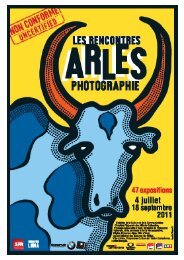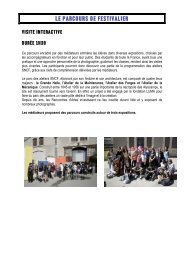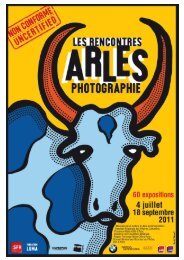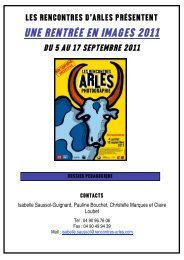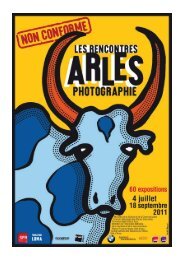Download - Les Rencontres d'Arles
Download - Les Rencontres d'Arles
Download - Les Rencontres d'Arles
Create successful ePaper yourself
Turn your PDF publications into a flip-book with our unique Google optimized e-Paper software.
The simulated suicide of the author<br />
What the artists on show in this exhibition also have in common is an upgrading of the amateur at the<br />
expense of the auteur. Their hero is no longer the technician, the expert or the professional armed<br />
with their specific savoir-faire, expertise or métier and in quest of a certain quality, but much more the<br />
amateur or collector, the impassioned practitioner of a hobby. At issue here is no longer the ‘death of the author’<br />
proclaimed by Roland Barthes in 1968, but his simulated suicide. For the appropriationist working in the totally<br />
digital age, the point is no longer to deny his status as author, but rather to play-act or feign his own death in<br />
the full knowledge that he’s not fooling anybody. Clearly, then, the issue is one not of newness, but of intensity.<br />
The small change of art<br />
The digital appropriationism surge that this exhibition only begins to map—and then gauchely—tells us one vital<br />
thing: we are sitting on veins of images, mother lodes that have been accumulating for almost two hundred years<br />
and are now expanding exponentially. Like the different resources that are a natural part of our planet’s composition,<br />
this form of energy embraces both the fossil and the renewable. It is also an extraordinary form of wealth. You only<br />
have to dig a little and sift gently for the water of the stream to bring the first nuggets to light. And the gold rush<br />
has already begun. On his grave in Batignolles cemetery in Paris André Breton’s epitaph reads, Je cherche l’or du<br />
temps: ‘I seek time’s gold.’ Breton was one of the first to realise that as an inexhaustible source of marvels, analog<br />
images constitute our greatest asset. His friend Paul Éluard, that passionate collector of photographic postcards,<br />
said that his finds were ‘at best the small change of art’, but that they ‘sometimes conveyed the idea of gold’. The<br />
artists making the most of digital technology resources in recent years have been working this vein. And working as<br />
trailblazers too, pointing us down the path to riches.<br />
Clément Chéroux<br />
CLÉMENT CHÉROUX<br />
Born in 1970. Lives and works in Paris.<br />
Clément Chéroux is a curator at the Pompidou Centre / Musée National d’Art Moderne. A historian of photography<br />
with a doctorate in art history, graduated from the École Nationale de Photographie d’Arles, he is the editor of the journal<br />
Études Photographiques. He has published several books: L’Expérience photographique d’August Strindberg<br />
(Actes Sud, 1994); Fautographie : petite histoire de l’erreur photographique (Yellow Now, 2003); Henri<br />
Cartier-Bresson : le tir photographique (Gallimard, 2008); and Diplopie : l’image photographique à l’ère<br />
des médias globalisés: essai sur le 11 septembre 2001 (Le Point du Jour, 2009). He also curated a number<br />
of exhibitions: Mémoire des camps : Photographies des camps de concentration et d’extermination nazis,<br />
1933-1999 (2001); Le Troisième œil : La Photographie et l’occulte (2004); La Subversion des images:<br />
surréalisme, photographie, film (2009); Shoot! Existential photography (<strong>Rencontres</strong> d’Arles, 2010).<br />
JOAN FONTCUBERTA<br />
Born in 1955 in Barcelona. Lives and works in Barcelona.<br />
With nearly four decades of prolific dedication to photography, Joan Fontcuberta has developed both artistic and<br />
theoretical work which focuses on the conflicts between nature, technology, photography and truth. He has done<br />
solo shows at MoMA in New York, the Art Institute of Chicago and Valencia IVAM among others. He has been<br />
guest lecturer in several international universities and currently is professor at the School of Communication at the<br />
Universitat Pompeu Fabra in Barcelona. His last books include Through the looking glass, La Oficina de Ediciones,<br />
Madrid; Indistinct Photographs, Edition Gustavo Gili, Barcelona; and Pandora’s box, Actes Sud, Arles. Artistic<br />
director of the <strong>Rencontres</strong> d’Arles in 1996, he was exhibited in 2005 and 2009 for the projects Miracles<br />
and co and Blow up Blow up.<br />
www.fontcuberta.com<br />
ERIK KESSELS<br />
Born in 1966. Lives and works in Amsterdam.<br />
Erik Kessels is a founding partner and creative director of KesselsKramer, an independent international<br />
communications agency located in Amsterdam. He works and has worked for national and international clients<br />
such as Nike, Diesel, J&B Whisky, Oxfam, Ben, Vitra and The Hans Brinker Budget Hotel. He has won numerous<br />
international awards. KesselsKramer comprises thirty-eight people of eight different nationalities and has been<br />
in operation since 1996. It believes in finding new ways for brands to tell stories using whatever media is most<br />
17



